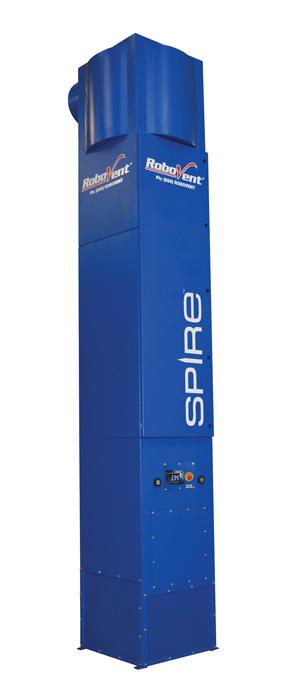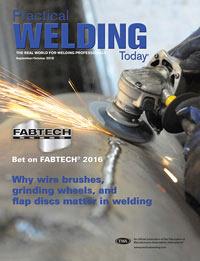- FMA
- The Fabricator
- FABTECH
- Canadian Metalworking
Categories
- Additive Manufacturing
- Aluminum Welding
- Arc Welding
- Assembly and Joining
- Automation and Robotics
- Bending and Forming
- Consumables
- Cutting and Weld Prep
- Electric Vehicles
- En Español
- Finishing
- Hydroforming
- Laser Cutting
- Laser Welding
- Machining
- Manufacturing Software
- Materials Handling
- Metals/Materials
- Oxyfuel Cutting
- Plasma Cutting
- Power Tools
- Punching and Other Holemaking
- Roll Forming
- Safety
- Sawing
- Shearing
- Shop Management
- Testing and Measuring
- Tube and Pipe Fabrication
- Tube and Pipe Production
- Waterjet Cutting
Industry Directory
Webcasts
Podcasts
FAB 40
Advertise
Subscribe
Account Login
Search
Evolving robotic welding fume extraction
RoboVent’s Spire system a play off its roots
- By Amanda Carlson
- September 19, 2016
- Article
- Safety

The Spire filtration system is based on three core factors: the spark arrester, an intelligent cloud-based control system, and a small footprint that still allows for accessibility should that be necessary.
Newton’s third law of motion states that for every action there is an equal and opposite reaction. RoboVent General Manager Jim Reid knows this all too well, especially when it comes to the relationship between robotic welding and welding fume.
When robotic welding first gained serious traction in the automotive manufacturing industry in the late 1980s, the technology completely changed the game in terms of the volume of work that could be done in comparison to manual welding.
So the action taken by the automotive industry at the time was to shift from manual welding to robotic welding. However, the equal and opposite reaction that no one planned for or had paid much attention to up until that time, Reid said, was weld fume.
“You can do about five times the amount of production in the same amount of space with robotic welding as you can with manual welding. But then you have to understand that the density of smoke in that building is five times heavier with robotic welding than with manual welding,” he said.
When Challenges Become Opportunities
You can trace the roots of RoboVent’s present-day Spire filtration system to the company’s earliest attempt at addressing robotic welding fume extraction when it was known as Great Lakes Air Systems. The FloorSaver™, what Reid describes as the first filtration system ever made especially for robotic welding, had all the qualities that space-conscious automakers were looking for at the time. The system mounts above the cell itself and is supported with four legs that take up a 10-in. by 10-in.
space for each leg, or 400 sq. in. total. It was a good concept and what the marketplace was looking for at the time, said Reid, but there were drawbacks.
The system’s core design made maintenance a headache. Tasks like changing out the filter, inspecting the spark arrester, and other maintenance requirements were complicated because all of the equipment was suspended over the top of the robotic cell. Nothing was easily accessible.
Also, staff had to be diligent in changing filters and ensuring the equipment was working properly to stay in compliance with air quality requirements. The more filtration systems, the more work necessary to stay on top of this task.
So five years ago the company began developing the next-generation robotic welding fume extraction system, incorporating all the best qualities of the FloorSaver while addressing its key problems.
In essence, they wanted to design a system that fabricators wouldn’t have to spend a lot of time worrying about.
The Spire filtration system is based on three core factors: the spark arrester, an intelligent cloud-based control system, and a small footprint that still allows for accessibility should that be necessary.

The pulsed self-cleaning filter system shakes the dust from the filters and into a collection pan, increasing the filter life to up to two years instead of two months.
While it requires a bit more floor space than the FloorSaver, at 900 sq. in., everything, including the spark arrester, the filters, and the blower, is accessible because it is all at ground level.
The system’s Delta3 spark arrester drives sparks and embers against the outer wall to quickly cool and extinguish the surrounding thermal envelope. The eTell™ control system, Reid said, is modeled after the Google Nest platform in that each dust collector is programmed to “talk” to this control system and alert the plant manager of any problems or required maintenance. A task list is sent via email to plant managers at the end of each month, alerting them of the systems that require attention or maintenance and how to do it.
The pulsed self-cleaning filter system shakes the dust from the filters and into a collection pan, increasing the filter life to up to two years instead of two months, Reid explained.
Reid said developing the Spire system posed several difficulties. One was designing a system that didn’t blow air out too forcefully. Because the blower is located at ground level, too forceful airflow could be disruptive to consumables like shielding gas during the welding process.
On a related note, building a system that was not deafeningly loud was also a challenge.
“The noise was a difficult component to handle because the blower is down at ground level. Since it’s a 15-HP blower, it’s pretty powerful.”
Challenges aside, Reid is happy that the company was able to combine the qualities it deemed important while addressing accessibility concerns in one system.
“We recognized that dust collectors and filtration systems are not what manufacturers want to buy, period. They are a necessary evil. They would rather spend their money on production equipment and their time performing maintenance on that equipment. They get frustrated when the dust collector starts eating into that,” Reid said.
RoboVent, 888-762-6836, www.robovent.com.
About the Author

Amanda Carlson
2135 Point Blvd
Elgin, IL 60123
815-227-8260
Amanda Carlson was named as the editor for The WELDER in January 2017. She is responsible for coordinating and writing or editing all of the magazine’s editorial content. Before joining The WELDER, Amanda was a news editor for two years, coordinating and editing all product and industry news items for several publications and thefabricator.com.
About the Publication
subscribe now

The Welder, formerly known as Practical Welding Today, is a showcase of the real people who make the products we use and work with every day. This magazine has served the welding community in North America well for more than 20 years.
start your free subscription- Stay connected from anywhere

Easily access valuable industry resources now with full access to the digital edition of The Fabricator.

Easily access valuable industry resources now with full access to the digital edition of The Welder.

Easily access valuable industry resources now with full access to the digital edition of The Tube and Pipe Journal.
- Podcasting
- Podcast:
- The Fabricator Podcast
- Published:
- 04/30/2024
- Running Time:
- 53:00
Seth Feldman of Iowa-based Wertzbaugher Services joins The Fabricator Podcast to offer his take as a Gen Zer...
- Industry Events
Pipe and Tube Conference
- May 21 - 22, 2024
- Omaha, NE
World-Class Roll Forming Workshop
- June 5 - 6, 2024
- Louisville, KY
Advanced Laser Application Workshop
- June 25 - 27, 2024
- Novi, MI
Precision Press Brake Certificate Course
- July 31 - August 1, 2024
- Elgin,































